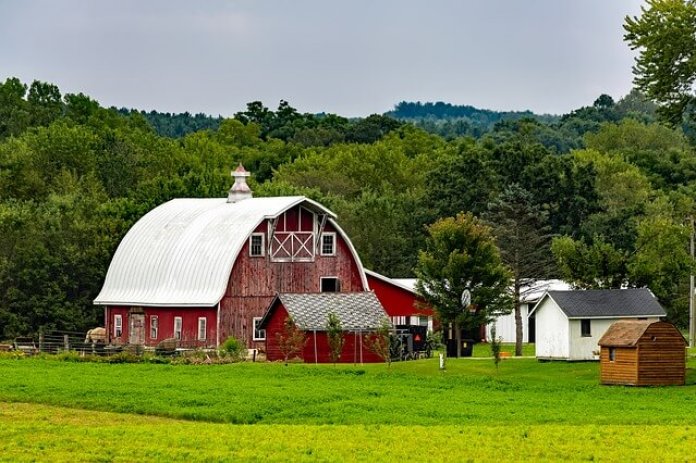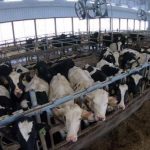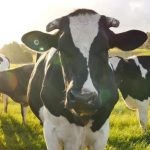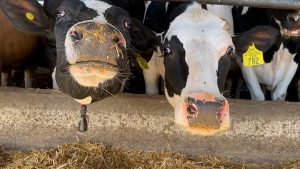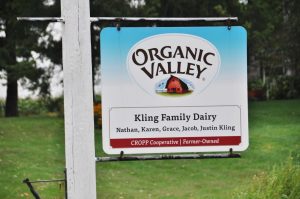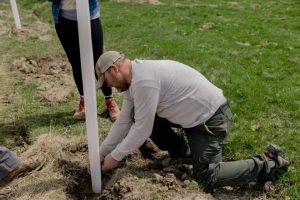
“The last two years have not been smooth sailing,” Ron Miller, general manager of the R&G Miller & Sons farm, says carefully when I ask how the family’s organic dairy farm is faring.
The Columbus-area farmer, one of six Miller family members running a venerable homestead farm that dates to 1852, is patiently explaining how the previous fall they couldn’t harvest crops or plant winter grains because of the wet fields that had mired the 1,600 acres they own and rent north of Sun Prairie.
This was a costly problem because the Millers, who milk 365 cows and have even more heifers and calves, want to grow everything they feed their animals.
But weather, a constant uncertainty in a farmer’s life, wasn’t the big problem challenging the Miller farm. It was the crash in organic dairy prices that had prompted the Millers to pinch pennies.
“We’ve always a run a tight ship, but we’ve had to cut back on capital purchases,” he explains. “Every year you want to replace some machinery so it doesn’t get too old and break down. Now we’re keeping things around longer.”
A dozen years ago, farms like the Millers’ were booming, and organic dairy farming was the biggest story in Wisconsin agriculture. Now the boom is darn near a bust. And for small town Wisconsin and the future of family farming that is deeply worrying.
Milk price collapse
A host of challenges are bedeviling Wisconsin dairy farmers. None more crucial than the collapse of milk prices. Our license plates may proudly proclaim “America’s Dairyland,” but the state’s registry of 7,292 dairy farms as of Jan. 1 — this includes both conventional and organic dairy farmers — tells a darker story.
In just five years’ time, 2,789 Wisconsin dairy farms have gone out of business. The long-simmering crisis briefly caught the attention of the Capitol this week, as evidenced by Gov. Tony Evers’s releasing a passel of modest proposals aimed at improving “rural prosperity.” Whether a hostile Republican-controlled Legislature will support them is hardly assured.
The Millers offer an instructive story of how the economic pressures are affecting an organic dairy. The family began making the dramatic shift from conventional dairying in 1992, fearing continued exposure to the pesticides, herbicides and chemical fertilizers used routinely in conventional farming were a health hazard.
“We all wanted to get away from it,” Tom Miller told me in 2007 when I profiled the Miller farm as an organic success story.
Reinhold Miller, the “R” in “R&G Miller & Sons,” had died of colon cancer at age 69 in 1994. “He did all the spraying, all the fertilizing,” said Jim Miller. “For me and my brothers, when we looked at Dad’s friends who did the spraying, they all got Parkinson’s disease, diabetes, or they’re dead. They all died prematurely.”
The Millers couldn’t prove their suspicions about these deaths. But like millions of Americans, they turned their back on the chemicalization of food production. Twelve years later, the Millers are still proud to wave the organic flag as owner-members of the Organic Valley farmers’ cooperative.
The problem, critics say, is that the organic flag has been captured by vast industrial-style dairies with 10,000 even 15,000 cows. These confinement dairies — the technical name is the unsettling bureaucratese “Concentrated Animal Feeding Operations,” or CAFOs — are widely criticized for not meeting organic requirements for pasturing cows that the Millers and other family farmers follow.
Just six of those giant organic dairies in Texas substantially out-produced all 453 organic-certified Wisconsin dairy farms in 2016, according to a block-bluster Journal Sentinel expose. Ron Miller blames the mega-dairies for flooding the organic market with suspect product and crashing prices for Wisconsin farmers
“It’s not fair to the farmers who do organic correctly,” he says.
‘The tragedy is industrial food producers took over’
The crisis in organic dairy comes at a moment of paradox. The federally governed organic program and its “USDA ORGANIC” label have flat-out triumphed in the marketplace. (USDA is the U.S. Department of Agriculture.)
You find the green-and-white organic label on milk cartons, vegetables, fruit and packaged products. You find it in big box stores like Woodman’s, Kroger, and Wal-Mart, membership warehouses like Costco, and, of course, righteous grocery co-ops like Willy Street in Madison and Middleton, Outpost in the Milwaukee area, and all the grocery co-operatives brightening Viroqua, Ashland and other smaller Wisconsin towns.
Nationwide, organic food sales hit a record $47.9 billion in 2018, up almost 6% from the year before, according to the Organic Trade Association. In Wisconsin, the powerhouse Organic Valley farmers’ co-op, headquartered in little LaFarge (pop. 763), saw its national sales top $1 billion for the third straight year in 2018.
But dig deeper and you find turmoil far and wide.
It’s not just the imbalance between the supply and demand for organic milk or an apparent double standard on enforcing organic rules either.
Everything from shifting consumer preferences to plant-based substitutes for dairy and beef, to the rise of soil-less hydroponic farming competing with organic dirt farmers, to the importation of fraudulent organic grain driving down the prices paid legit organic growers for their corn and soybeans have all soured organic’s financial sweet spot.
“(Up until) five or six years ago, it really looked like organic was going to be the salvation of farming,” says Dave Chapman, a Vermont farmer who runs the Real Organic Project advocacy group.
“Great! We had a label that recognizes that,” says Chapman. “The tragedy is that industrial food producers took over the label. They had the influence to twist the rules to their advantage.”
The new reality
Chapman’s views are widespread among organic’s pioneers, many of them Badgers who were in the front lines of the organic movement. But the answer to the hard question of what be should be done to right the organic ship is not at all clear. Should the advocates fight to restore the organic program’s original intent? Or should they roll with the times and accept the popularization of factory-style, low-cost organic products as a good thing? Or should they give up entirely on the federal program and push to create new, purer voluntary labels that lack federal oversight but signal such attributes as grass-fed, free-range, ethical or fair-trade?
“Organic is at a turning point in facing up to the reality of its marketplace,” says Ed Maltby, executive director of the Northeast Organic Dairy Producers Alliance. “It’s grown beyond being a niche product to a full-blown commodity. So it’s facing the new reality of its own success.”
That new reality, says Maltby, is: “Success always breeds imitations.” And conspicuously missing from the imitations is recognition of the mission-infused history of the organic movement.
The origins of the organic movement trace back to J.I. Rodale, one of those great eccentric geniuses of American enterprise. Straight outa Manhattan, Rodale became the leading crusader for organic farming in the nation. In the 1940s, he packed up for the rural countryside of Emmaus, PA., where he mixed experimental farming and publishing. Popularizing the ideas of English agricultural researcher Sir Albert Howard, Rodale proselytized for non-chemical farming and building soil nutrients through natural fertilizers.
Composting! Rodale set the stage for it to become the hip thing to do decades later.
His magazine, eventually known as Organic Gardening, became the movement’s bible, drawing more than 700,000 subscribers at its peak. A health food enthusiast of sometimes fringe beliefs, Rodale also published the even bigger-selling Prevention magazine.
“Healthy Soil = Healthy Food = Healthy People” became Rodale’s chalkboard summary of organic farming. It was not just a technique, but also a philosophy of how people saw their place in the natural world. His message still resonates today.
“The commitment to the organic system is stronger when it comes from an ethical and moral background, ” says Harriet Behar, a veteran Gays Mill farmer and inspector of organic farms under the federal law.
“When I go to those farms, I feel better,” Behar says. “I’m seeing how organic agriculture works the land. I’m seeing how it improves the soil. I see the milkweed and monarch butterflies it attracts to the edges of fields.”
Wisconsin rocks the organic world
Wisconsin has long been at the epicenter of the holistic thinking surrounding organic farming.
The seven farmers led by George Siemon who began meeting in December 1987 to form the Organic Valley co-op are a legend in the organic narrative. These Coulee Region upstarts included more than a few “back to the land” hippies. The militant National Farmer Organization offered technical and financial assistance to the nascent farmers co-op. These were all folks who had a vision of stabilizing gyrating milk prices for family farmers while producing healthy food sold at a premium price to consumers who valued the organic approach.
From these humble beginnings, the Wisconsin phalanx of organic warriors grew.
The Cornucopia Institute, co-founded by Mark Kastel and Will Fantle, became the nation’s premier organic watchdog, regularly barking at cheats and assessing organic’s best and worst practices.
Agricultural economist John Bobbe, of Scandinavia (in Waupaca County), emerged nationally as the sleuth who uncovered the bogus organic grain being shipped from the Black Sea to the U.S. John Peck of the Madison-based Family Farm Defenders has been battling corporate agriculture for decades.
Jim Goodman, a retired Wonewoc beef and dairy farmer, may be the best op-ed writer around expounding the organic viewpoint as seen from the barn door. Behar until December chaired the all-important National Organic Standards Board, which advises the USDA on organic policy.
Wisconsin rocks the organic world, though none of these folks are widely recognized.
The organic movement’s real power resides not in celebrated leaders trending on Twitter but in the collective decisions of millions of organic-minded shoppers who put their money where their values are every time they buy groceries.
Up until recently, this dynamic has worked wonders for farmers.
Now not so much.
“After 30 years [of supporting organic farmers] consumers are backsliding,” says Siemon, the former Organic Valley CEO. “They’re moving away from organic milk to non-organic plant-based drinks.”
“It’s disappointing,” he says.
‘Food as software’
Check out the dairy case at your favorite grocery. You’ll see how consumer preferences have shifted against organic dairy farmers. When I periodically check the dairy case at the Willy Street co-op’s near-eastside store, I find it packed with plant-derived drinks from soybeans, almonds, hemp, oats and cashews. Often these drinks are deceptively labeled as “milk” as though, like cow’s milk, they are a product of lactation, when they are in truth a laboratory concoction of additives.
Plant drinks, though, are on a roll. They account for 15% of all U.S. “milk” sales, according to The Economist magazine. Nearly 40% of American households have tried these beverages in the past year.
When I asked Megan Minnick, Willy Street’s purchasing director, why the co-op was party to a marketing deception that hurt Wisconsin’s dairy farmers, she said no one who buys these drinks thinks they’re actually milk.
“It’s clear from the label what the ingredients are,” she says. That disclosure is key to the co-op’s acceptance of the drinks as a milk substitute. “People should be allowed to make their own choices,” she says.
“We represent 35,000 owners so we really have to make our decisions based on what the ownership wants. Like it or not, plant milks are a huge trend. Our owners want to buy it, so we provide it.”
Co-op milk sales are “pretty flat,” Minnick acknowledges.
The shift away from milk has been spurred by rising dietary concerns. Most adults experience varying degrees of abdominal distress from lactose intolerance, which is the inability to digest a sugar found in dairy products. More serious are occasional life-threatening milk allergies that upwards of 3 percent of babies suffer from. Milk’s problems have only increased with an unsettling United Nations report that asserts dear old Bossy the cow accounts for a big chunk of greenhouse gasses warming the globe.
Even greater disruption may be around the corner.
Plant-based meats are now threatening organic beef farmers in Wisconsin as well. The Beyond Meat and Impossible Foods’ rollouts of new veggie meats have stoked extraordinary buzz. (Impossible has raised $700 million in venture investment.) Even the normally restrained Economist magazine declared they “could create a radically different food chain.”
One think tank, RethinkX, has even made the vertigo-inducing prediction that the beef and dairy industries will outright collapse by 2030 due to breakthrough technologies in what it calls “precision fermentation” and a new “food as software” production model. RethinkX confidently tells us these innovations will drastically lower costs and produce newly engineered lab-cultivated proteins at a bargain cost.
Mark Kastel, who’s now with the investigative group OrganicEye, is deeply skeptical. He says these products really aren’t food. “They are incredibly highly processed analogs that simulate food,” he says. “You’re taking non-organic base commodities, putting them through genetic engineering, or a laboratory process, and coming up with an imitation food product.”
It’s just so much more “Silicon Valley baloney,” as veteran dairy industry commentator Pete Hardin of The Milkweed dryly puts it. Hardin cautions that regulatory rules have been so dialed back that these bio-engineered foods could be disastrously introduced to the marketplace with remarkably little testing of their human health consequences.
International crime syndicates
A farm apocalypse that might be a decade or so away doesn’t quite focus the mind of farmers as does the grim monthly reality of the depressed grain and milk prices eroding their profitability and farm equity.
Take the organic grain coming to the U.S. from Russia, Turkey, Ukraine, and Kazakhstan. It’s magical because it leaves the Black Sea ports as conventional corn and soybeans and arrives at U.S. ports with organic credentials, as The Washington Post has reported.
John Bobbe, who traveled to the Black Sea to investigate, says international crime syndicates are big players in the fraud. When U.S. farmers failed to produce enough organic grain to meet the exploding demand for feed for organically raised chickens, prices shot up as high as $17 a bushel for corn.
Bobbe says chicken farmers turned to oversea sources. Those foreign exporters flooded the U.S. market with fraudulent organic grain, which drove down prices to around $8 a bushel — $2 less than what Bobbe says was the break-even price for American farmers.
Had the bushel cost settled at a profitable $12 instead of a money-losing $8, he figures American farmers would have earned an additional $750 million to $1 billion for their organic grain.
“Seventy percent of the organic soybeans and 40% of corn are imported,” Bobbe says of the American market. “The question is how much of it is fraudulent? We don’t know.”
Good news, bad news
The good news is that the 2018 Farm Bill included increased funding for tougher enforcement of organic standards for imported grain. (Wisconsin Sen. Tammy Baldwin was a key supporter.) The bad news is that the crash in dairy prices seems more intractable because the alleged malefactors didn’t forge documents, they got organic inspectors to “green wash” their practices, such as feeding the cows chopped forage in their confinement pens instead of letting them graze in pastures
“You got problems when the rules aren’t being followed by these big farms,” says Pete Kondrup, general manager of the Westby Cooperative Creamery in Vernon County. “They can manufacture milk a lot cheaper.”
That flood of Texas organic milk from six mega-dairies destroyed the premium price that Wisconsin’s 400-plus dairy farmers enjoyed for producing organic milk for years and years.
In 2015, that premium price of about $35 was $17 to $18 higher than the non-organic dairy farmer down the road earned per hundred pounds of milk (about 12 gallons), says Kondrup.
By fall 2019, the organic price had dropped to $27 or $28, and the price advantage narrowed to $7 to $10, depending on the month.
“While the pay-price for organic milk dropped significantly, everything else got more expensive,” Kondrup says of operational costs in the 2015-19 period. “That makes it very hard for farmers to hang on.”
Signs of decline
Ominously for Wisconsin, the Organic Valley farmers co-op is struggling, losing money the past two years despite three years of $1 billion in sales. The downturn corresponded with the unexpected retirement of Siemon as CEO. The resulting belt-tightening has come at the expense of the co-op’s nearly 2,000 owner-members in 34 states and several foreign countries.
More than a quarter of them farm in Wisconsin, most clustered in the hills and valleys of the picturesque Coulee Region where the co-op was founded. OV’s economic clout remains both substantial and vital to rural Wisconsin.
Besides its 538 family farms in Wisconsin, Organic Valley has more than 800 employees in the LaFarge headquarters and in neighboring Cashton where the co-op’s distribution center is located, says OV publicity coordinator Elizabeth McMullen.
These are big numbers. All the more so because rural Wisconsin has been in decline for several decades, losing population, young people in particular, and many good jobs. The rural opioid epidemic is one result..
A few years ago, the Union of Concerned Scientists reported that mid-sized farms like the Organic Valley members employ more people per acre, spend more money locally, and are more closely associated with socio-economic stability than are industrial-scale farms.
John Peck of Family Farm Defenders makes the same point. “The multiplier effect of 50 family farms with 100 cows each versus five factory farms with 10,000 cows each is vastly different,” he says. “Most of the really big outfits…don’t even buy anything locally anymore.”
You get no argument from Mark Stephenson, director of UW-Madison’s Center for Dairy Profitability. “Smaller farms tend to spend a greater percentage of their money locally,” he affirms.
Those farmers also patronize local cafes. They volunteer for church boards and non-profits. They send their kids to the local schools. They are essential, in other words, for sustaining the rural economy and the durable fabric of rural life.
What happens if farmers become as scarce as hen’s teeth?
